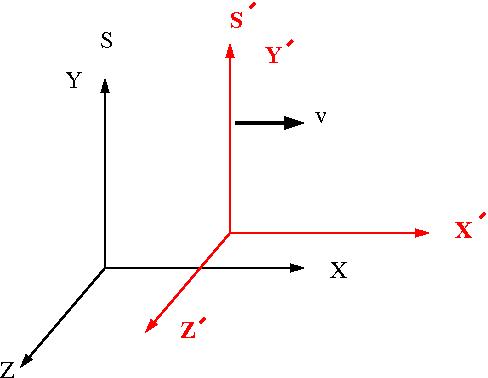Difference between revisions of "Forest Relativity Notes"
| Line 142: | Line 142: | ||
:<math>P^{\mu} = (E,\vec{p}_{tot}) =(M,\vec{p}_{tot}) = \left ( p_1 \right )^{\mu} + \left ( p_2 \right)^{\mu}</math> | :<math>P^{\mu} = (E,\vec{p}_{tot}) =(M,\vec{p}_{tot}) = \left ( p_1 \right )^{\mu} + \left ( p_2 \right)^{\mu}</math> | ||
| − | Assuming that the Mother particle is moving along the Z-axis, then the momentum of the daughter particles which perpendicular to the Z-axis (transverse components:<math>\vec{p}_{1,\perp}</math> and <math>\vec{p}_{ | + | Assuming that the Mother particle is moving along the Z-axis, then the momentum of the daughter particles which perpendicular to the Z-axis (transverse components:<math>\vec{p}_{1,\perp}</math> and <math>\vec{p}_{2,\perp}</math>) are equal and opposite by conservation of momentum. |
| + | |||
| + | :<math>\vec{p}_{\perp}\equiv -\vec{p}_{2,\perp}</math> | ||
Revision as of 02:11, 31 October 2007
Lorentz Transformations
The picture below represents the relative orientation of two different coordinate systems . is at rest (Lab Frame) and is moving at a velocity v to the right with respect to frame .
The relationship between the coordinate of an object in frame to the same object described using the coordinates in frame is geven by the Lorentz transformation:
4- vector notation
The 4-vector notation is given as
where
- NOTE
- It is common in particle physics to define making where is in units of
- example
- Or in matrix form the tranformation looks like
- Note
- Einstein's summation convention drops the symbols and assumes it to exist whenever there is a repeated subscript and uperscript
- ie;
- in the example above the symbol is repeated thereby indicating a summation over .
Momentum 4-vector
- Note
- There is another convention used for 4-vector notation by Perkins and Koller which goes like this
Trig Method
Another way to represent the lorentz transformation is by using the substitution
- The Matrix form pf the tranformation looks like
- Or the reverse transformation
- Notice that you just needed to change the signs for the inverse matrix
Proper Time and Length
Proper Time
- Proper Time
- The time measured in the rest frame of the clock. The time interval is measured at the same x,y,z coordinates because the clock chose is in a frame which is not moving (rest frame).
The time given in any frame (t) =
- Note
- since you expect the Proper time interval to be the smallest
Proper Length
- Proper Length
- The length of an object in the object's rest frame.
Invariant Length
Transformation Examples
Decay of Particle to 2 Bodies
Consider the decay of the meson at rest into two pions ( and )
File:NeutralRhoMesonDecayDiagram.jpg
The diagram above shows a meson at rest in the lab which then decays into two pions of momentum and in the center of momentum frame of the meson.
If represent the total momentum of the system before the decay then
or
Let
Conservation of Energy
solving for p
- is required to avoid the unphysical condition that the momentum of the particles after a decay would be an imaginary number
Using
Combine this with the conservation of energy equation above:
Square both sides of the above equation
Similarly
- Note
- The daughter particles (pions) from the decay of the Mother particle travel in opposite directions with respect to eachother ( ie; they are "back - to -back")
- This means that there is no preferential direction for the decay (the particles are distributed isotropically such that they are back-to-back)
Decay of Moving Particle to 2 Bodies (decay in flight)
Assuming that the Mother particle is moving along the Z-axis, then the momentum of the daughter particles which perpendicular to the Z-axis (transverse components: and ) are equal and opposite by conservation of momentum.
